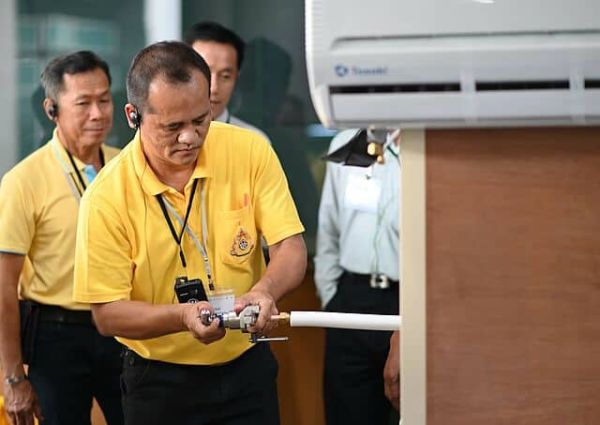Final Evaluation and Learning Exercise Report of Thailand Refrigeration and Air Conditioning is Now Available

The Thailand NAMA Support Project “Thailand Refrigeration and Air Conditioning” (Thailand RAC for short) seeks to initiate a sector-wide transition towards the use of climate-friendly and energy-efficient cooling technologies.
With this in mind, AMBERO and Oxford Policy Management undertook a final evaluation and learning exercise (ELE) on the progress of the Support Project, between January and April 2021.
Some of the ELE’s main findings include:
- The Support Project has demonstrated strong and consistent alignment with national priorities and needs. The Support Project has responded to the national policy on energy efficiency including energy-efficient cooling technologies supported by Minimum Energy Performance Standards (MEPS), the RAC energy efficiency programme “Label No. 5” and the Thai government’s energy efficiency programme.
- The needs of direct beneficiaries, including Thai government agencies, RAC manufacturers, service technicians, commercial and individual end-users, have been supported by the Project. RAC manufacturers now have safety standards that are in harmony with international standards. Service technicians have started receiving technical information about natural refrigerants.
- Several refrigerator manufacturers have completed production line conversion with the technical and financial support of the Project. The Support Project has produced outputs that enabled the phasedown of high-GWP cooling technologies and the development and wide acceptance of climate-friendly and energy-efficient cooling technologies in the refrigeration sub-sector. This has been in part due to the availability of commercially viable low-GWP product and process technologies among refrigerator manufacturers, which enabled their production line conversion.
- However, the same success did not occur in the air conditioning sub-sector, largely due to legal/regulatory and market introduction barriers. On top of this, the lack of available commercially viable low-GWP product and process technologies among air conditioning manufacturers has hampered their production line conversion. Air conditioning manufacturers are thus still using high-GWP refrigerants.
- The NSP’s initiative to establish the Cooling Innovation Hub and Cooling Innovation Fund using the RAC NAMA revolving fund is a good sign of the Support Project’s continuity beyond its lifetime. However, there are some critical factors that need to be ensured to avoid reversing whatever gains the Support Project has achieved, such as the ratification of the Kigali Amendment by the Government of Thailand with clear provisions for the upper GWP threshold.
The evaluators of the ELE derived lessons learnt and accompanying recommendations for future Support Projects in the RAC sector:
- The safe use of natural refrigerants in high-rise buildings needs to be exhibited by the local safety engineers. These experts are often perceived to have greater technical credibility than those from international development organisations.
- There is a need to establish fundamental good working relationships with international and domestic RAC product developers through a collaborative R&D unit, with a knowledge-sharing platform, to ensure seamless access to new patents for refrigerants and related emerging technologies. Working with these companies directly, could open discussions for the adoption of natural refrigerants in their product mix.
- The marketing of RAC products, which already includes information campaigns such as those launched by the Support Project, is best left to the Thai RAC manufacturers’ extensive network of marketing professionals. Once they start using natural refrigerants, local and multinational RAC manufacturers based in Thailand can exploit their extensive networks to launch marketing campaigns for new and improved products.
Following the main findings and recommendations of the ELE, the TSU has compiled a management response to address the key points that were raised.
Read more about the project.
Read the full ELE report in our Knowledge & Learning Hub.
The NAMA Facility is supporting NAMA Support Projects (NSPs) that effect sector-wide shifts toward sustainable, irreversible, carbon-neutral pathways in developing countries and emerging economies. All NSPs with an overall duration of more than three years are subject to a mid-term and to a final evaluation and learning exercise (ELE). These ELEs are part of the NAMA Facility’s working approach to catalyse transformational change through incremental monitoring processes that allow fearless learning.
The TSU has commissioned AMBERO and Oxford Policy Management to conduct the ELEs. The exercise is based on a theoretical framework which involves a document review, participatory workshops and stakeholder interviews to collect evidence about NSPs’ results and lessons. These elements are then analysed using a theory-based approach centered on the use of contribution analysis and reinforced by elements of process tracing. The ELEs seek to address the following questions:
Has the NSP achieved its results?
Has the NSP started to trigger transformational change?
What was learnt from the NSP so far?
